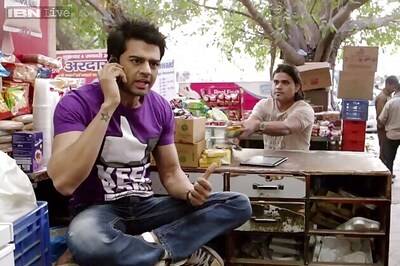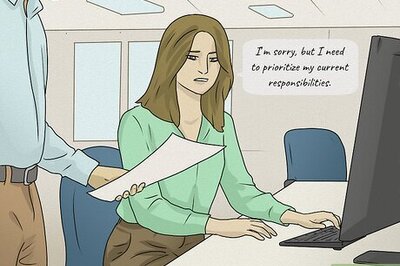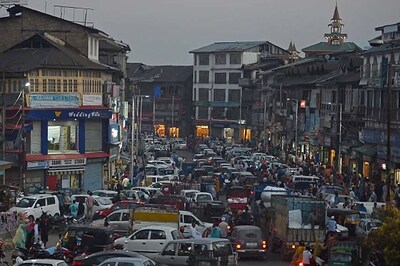
views
New Delhi: Last month, Aam Aadmi Party leader Atishi had News18 in an interview that the government's main focus in Delhi would be women's safety. Just days after Atishi lost to Gautam Gambhir and the AAP was wiped out in all seven Lok Sabha seats, on Monday morning, chief minister Arvind Kejriwal announced that women in Delhi will soon be able to travel free on public transport.
Of course, hell hath no fury like men on the Internet realising that there's no free ride for them. But outrage followed, from both men and women.
While many pointed out that it will hurt the finances of an already debt-ridden Delhi metro, the AAP has said that the DMRC will not suffer at all because of this. An AAP spokesperson said that the ticket revenue lost by Delhi Metro will be reimbursed fully by the Delhi government. But will this measure really improve the safety of women commuters? The first question that comes to mind is: How safe are women really in public transport in the first place?
Well, to begin with, unless women start occupying public spaces, how do you even create safe spaces for women? Rupa Nandy, head of UITP India, an international organisation for public transport authorities and operators, said that if more women start using public transport there would be a modal shift from various other modes such as shared taxis, bikes, autos, buses and metros. Nandy said that this would increase safety in two ways. "First, with more women at various times of the day in buses and metros- women travellers would feel safer. Second, many informal modes of transport are unregulated and do not drive safely. Buses and metros will be much more comfortable."
However, one thing that is clear amidst all these debates is that if the policy of free rides is implemented, more and more women will use public spaces, and that can only mean a brighter, better future for the Indian economy.
The AAP government says only 33 percent of metro commuters in Delhi are women. This means there are around 7 lakh women for every 16 lakh male commuters, daily. If this apparent election sop actually helps in bringing more women in the public space, like the government hopes, it may eventually lead to a better economy.
Mitali Nikore, a feminist economist, agrees. "I think this is a path breaking move," she said. Nikore believes that a lot of women do not take up jobs because it involves travel. "It's going to empower women in many ways," she said. The Census (2011) data for cities (tier I, II and III) shows that women form only 22 per cent of all people travelling for work across India. In Delhi, the figure is a mere 15 per cent. The economist point out that many of the choices women make are based on the distance they have to travel.
Studies all over the world have demonstrated that men and women use public transport differently. In India, even in car-owning households, it is usually the men who drive, while women take public transport to travel to the workplace, drop and pick-up children, and carry out a whole range of other activities.
A study conducted by the United Nations showed women often “chain” their activities by combining multiple stops and destinations because of their caretaking responsibilities. This, in turn, makes it costlier for women to use public transport, since they may have to pay for numerous single-fare tickets through their trip. Also, too often, especially in India, women travel with children and elderly parents, adding complications and inconvenience if transport isn't reliable or simple to use.
Women also travel at lower speeds and spend a higher percentage of income in transport than men, limiting their access to certain employment areas.
Meanwhile, the dire condition of employment in India is no surprise--Between 2011 and 2015, the unemployment rate rose from 3 per cent to 5 per cent. In all this, the female labour force participation rate (FLFPR) declined from an already low 34.8 per cent to 27 per cent in the two decades before 2013, according to a World Bank report. In that time the economy has more than doubled in size and the number of working-age women has grown by a quarter, to 470 million. As opposed to 79 per cent men, only 27 per cent Indian women were a part of the workforce in 2017.
The reasons can be many for this low female participation rate in the labour force. One is the lack of agency. Two, safety. In fact, when looking at constraints to women’s mobility, there are two dimensions: instrumental aspects (such as affordability and availability of transport options); and less tangible, psychological and sociocultural factors such as aspirations and self-esteem. Kejriwal's announcement of making public transport free for women is likely to solve the first bit.
What is undeniable, is that India, the world’s fastest-growing major economy, could do a lot better if it added more women to its workforce. The free rides may help more women step out, and in turn, more employment. In fact, studies also show that countries that make more women-friendly transport are also able to generate more employment.
"Kejriwal's new move will overall reduce the cost of travel at an individual and family level. Hence, there would be more women joining the workforce, more women would step out for leisure activities as well," Nandy said. She also pointed out that this would mean more women in public spaces giving the economy a boost.
However, Nandy said that many women don’t take public transport due to unavailability and inconvenience. "These two basic factors will also have to be taken care of along with providing free transport," she added.
According to a report by the McKinsey Global Institute, India could add up to $770 billion—more than 18 per cent—to its GDP by 2025, simply by giving equal opportunities to women. International Monetary Fund’s (IMF) chief Christine Lagarde had said in several interviews that the additional workforce would make India 27 percent richer.
For India to grow and more women to be a part of the labour force, the first step is to ensure their safety and easier, cheaper ways of getting to work. "The jobs that men did earlier may be passed to women because it will be free for them to travel. That, in itself, is the first step towards empowerment," Nikore said.
But what about the cost that the Delhi government will incur? Kejriwal, in his press address, said that it would cost the Delhi government Rs 700 crore. Earlier this year, the Delhi government presented a Rs 60,000 crore budget for 2019-20 laying emphasis on the education, health and transport sectors and said it is “two times more” than the one presented in 2014-15. That's not even 2 percent of the total budget. "Every government should aim to achieve better and efficient public transport. The cost that will be borne will lead to a big result. That is what is important," Nikore said.
While reporting on elections a couple of months ago, this reporter met a few housewives in Delhi to understand what they feel about their work not being included in the GDP. There was no clear cut response, but most of them wanted to find work somewhere closer to home. The reason why they wanted work opportunities near their home is not difficult to understand-- the role of caregivers will still be on them.
Manorama, 34, a resident of Ashok Nagar area in Delhi, had started a beauty parlour about five years back close to her neighbourhood. "It was my dream," she said. A couple of months after she realized she was financially independent and could make a lot of decisions on her own, her daughter fell sick. Manorama was forced to close the shutters of her parlour. "My husband is not very co-operative. He didn't even want to drop me to my parlour when I was running it. He would blame it on the rising petrol price, so I would walk every day."
Whatever the naysayers say, there must be thousands of Manorams living in Delhi. Perhaps, Kejriwal's election sop and a free ride will be the beginning of a dream they can finally achieve.




















Comments
0 comment